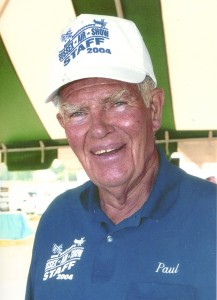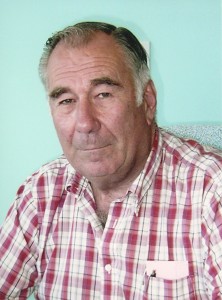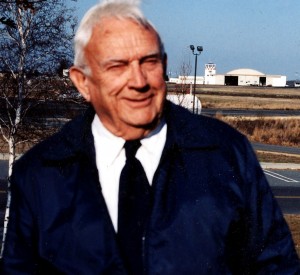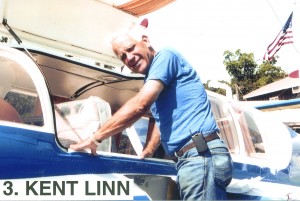
Kent Linn, boarding one of his Russian Beriev Be-103s, holds exclusive U.S. sales rights to the Russian twin-engine amphibian aircraft.
By Jack Elliott
Three of New Jersey’s best-known general aviation airports are currently on the block: Sky Manor Airport (N40), Sussex Airport (FWN) and Monmouth Executive Airport (BLM).
Sky Manor Airport in Pittstown, located in the verdant rolling hill country of Central Jersey, recently sold. Kent Linn, the airport’s owner since 1979, is in the process of building an airpark community requiring each homeowner to have an attached hangar. Every home will be built to the homeowner’s specifications and will have access to the single runway, recently lengthened by 461 feet to 2,900 feet.
Linn will maintain possession of the 46-acre airpark community, subdivided into 19 one-and-a-half- to three-acre lots. The roads and underground utilities are in place, and building will start shortly. Some lots are still available.
A maintenance operation, a flight school and a hot air balloon company operate from the airfield, as does Sky Manor Restaurant, one of the most popular airport restaurants in the state. Sixty T-hangars with electric bi-fold doors and 18 older hangars with sliding doors are onsite.
Gerald Innella, a former United Airlines and corporate jet pilot, and his friend Dr. John H. Hajjar, a urologist and owner of a Falcon 2000, purchased the 73-acre airport. Linn holds the U.S. sales rights to the Russian twin-engine Beriev Be-103 amphibian; Innella is the pilot for that operation.
Sussex Airport, owned by Paul Styger and located in the hill country of northwest New Jersey, developed a national reputation as the site of one of the best small airport air shows in the country. Virtually every top air show performer in the country including Bob Hoover, Charlie Hillard, Tom Poberezny, Jimmy Franklin, Jim LeRoy, Art Scholl, Patty Wagstaff and a host of others have appeared in the 32 annual air shows Styger staged at the airport.
The French Connection performed regularly in the show, and the Ray Ban Golds, the Red Devils and the Holiday Inn team were among those that appeared in the shows over the years. The airport was home base for Leo Loudenslager, seven-time National Aerobatic Champion and 1980 World Champion. Loudenslager, who died in a motorcycle accident in 1997, appeared in nearly all of the Sussex shows. Although Sussex is a relatively small country airport (its single runway is 3,499 feet long), some years the show attracted more than 15,000 spectators. It was originally a two-day affair and later stretched to three days; the airport hosted the last show in 2004.
Styger laid out Sussex Airport as a college project in 1947 while studying aeronautical engineering at Rensselaer Polytechnic Institute. Each student had to design an airport; Styger picked a farm near his home in Sussex as the site. In 1949, he bought the 100-acre property and built the airport he designed in college.
Monmouth Executive Airport in Wall Township, not far from the Jersey shore, has a very colorful history. Ed Brown started the airport in 1938. Brown died in June 2006, at the age of 89.
His stepson Jack Taylor, who now runs the airport, said he often claimed that the 645-acre airport—with a 7,300-foot runway and a 3,307-foot cross-runway—was the “largest privately owned airport in the country.”
“That statement was sometimes challenged,” Taylor said. “Every time somebody said, ‘There’s a bigger one,’ he’d say, ‘Tell me where.’ They couldn’t.”
The airport, previously known as Allaire Airport and Monmouth County Airport, started when Brown bought a gravel pit from the widow of Arthur Brisbane, one of the outstanding journalists of his time. Brown and a friend had taken airplane rides at an airport near Hightstown, N.J. Each flew with a different pilot. His friend was told he would make a great pilot; Brown’s pilot said, “Forget it. Find something else to do.”
“That was a big joke around here,” said Taylor. “Don’t tell him you can’t do something, because that’s what we’ll be doing tomorrow.”
Brown got his pilot’s license and bought a J-3 Cub, which he kept on a nearby farm. He wanted a piece of land to keep his airplane on. When he bought the gravel pit, it needed clearing and leveling, requiring heavy equipment. Brown, a supermarket cashier, couldn’t afford that.
But he had a different idea. A memorial park in the nearby town of Belmar had a World War I tank on display. Brown asked if he could borrow it to clear and grade his land. When they said it wouldn’t run, he said he could make it run. Brown found a carburetor, a magneto and some steel plates at a junk yard and repaired the tank. Once he had it running, the memorial park loaned him the tank. Brown made a deal with some children: if they brought a can of gas, they could get a ride in the tank. The kids provided most of the gas. Monmouth Executive Airport began when Brown carved out a runway with the tank.
Brown always did all the work on the airport himself. Over the years, he bought the heavy equipment he needed, including a large front loader, a back loader, a bulldozer, an earth-moving machine and several dump trucks. He said it was cheaper to buy the equipment than to rent it. He hired two men to operate the machines. He used them to carve out the 7,300-foot runway in increments.
Brown was never without an idea for adding something new and different to his facility. In the 1980s, he built a drive-in/fly-in movie theater, the Shore Drive-In. After landing, the airplanes taxied in, then parked behind the cars. Entertainer-pilot Arthur Godfrey, a great promoter of aviation, once flew in to watch a movie.
He built a huge bowling alley, and rebuilt the Air Lanes Bowling Alley after it burned down in 1965. There wasn’t enough business to fill both sides of the bowling alley, so he eventually converted one side into a nightclub.
He had a golf driving range for a time and planned to build a golf course on airport land. Perhaps his most imaginative use of his airport land came when he built an amusement park at the airport, complete with a Ferris wheel, merry-go-round and miniature railroad. The town claimed the Ferris wheel was a hazard to the airport, although it wasn’t near a runway.
Brown tangled frequently with township officials. He paid more than $900,000 a year in taxes and felt that as the largest taxpayer in the town, he deserved more consideration; in his opinion, the town constantly harassed him. He eventually closed the amusement park and sold the rides in order to end the conflict.
He erected a huge convention hall with kitchen facilities and lots of parking. Brown initially rented it to an organization running a boat show. However, the town wouldn’t let him use it as a convention center because he booked the show before they granted approval for use of the building as a convention center. Bruce Springsteen, an area resident, used the facility once to rehearse a new show. As a convention center, the building might have attracted business to the Monmouth area; today it’s a storage center.
At one time Brown published a weekly newspaper, housed in a building on the airport grounds. He also built a huge building for the Aircruiser Co., manufacturer of “Mae West” life jackets and rubber lifeboats. Today the company specializes in equipment for airliners, such as escape chutes and under-the-seat life vests.
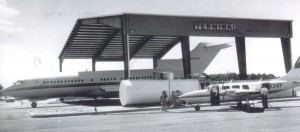
Although this 727 is parked under the gas pit canopy at Monmouth Executive Airport, that type of aircraft is currently not permitted to land at the airport.
Another of Brown’s innovations was a huge canopy over the gas pit, big enough for a 727 to taxi under. He got the idea from something he saw at an airport in the Midwest. At one time, 727s used the airport, but it no longer accommodates them, due to questions about the weight-bearing capacity of the runway. The airport does serve business jets and special events in the area, attracting them in large numbers for events, including the Breeder’s Cup Race at Monmouth Park Race Track. The airport is near the PNC Bank Art Center (formerly the Garden State Arts Center), where top performers appear. These concerts also attract a number of jets to the field.
The airport has approximately 250 aircraft based on field, including eight jets. Two flight schools, a sky diving operation and a banner-towing company operate at the airport. There are approximately 50 buildings on the airport property.
Brown worked 69 years at his airport. That’s impressive, but the most amazing aspects of his career were the innovations he developed. With Brown at the helm, those nearly seven decades held no dull moments.
Onyx Equities LLC, a New Jersey-based private real estate investment and property management firm, recently purchased the airport. Onyx is in the process of doing due diligence and expects the purchase to be closed by year-end. The airport built from scratch appraised at $41 million a few years ago; Onyx has not revealed its purchase price for the property.
Taylor said Brown wanted the property to remain an airport. Township officials have received assurances that Onyx will continue operating the airport; the only change Onyx has announced so far is that use of the field will be restricted to small aircraft.












